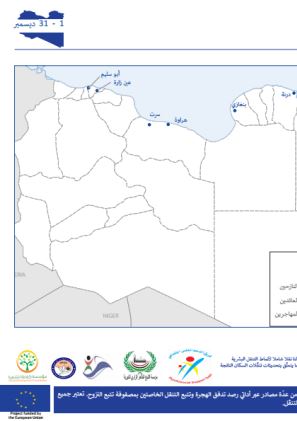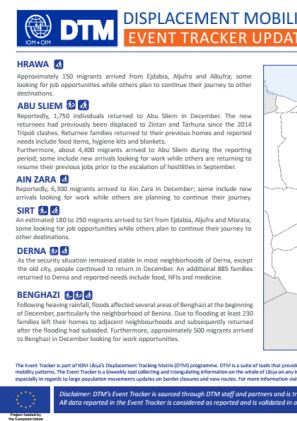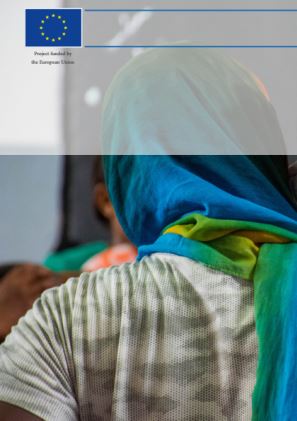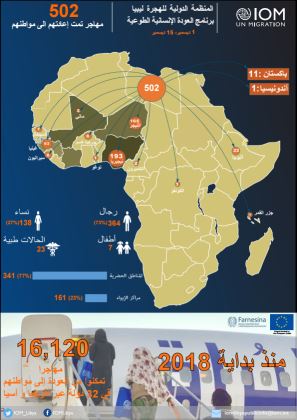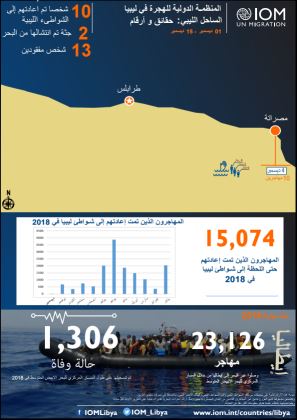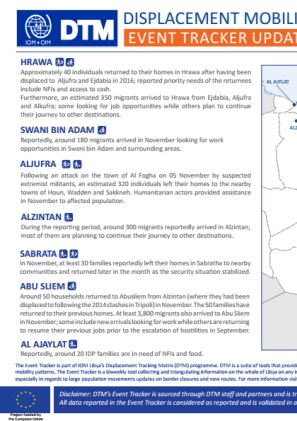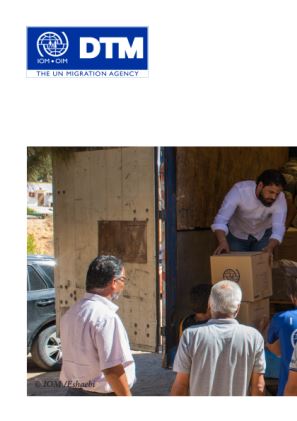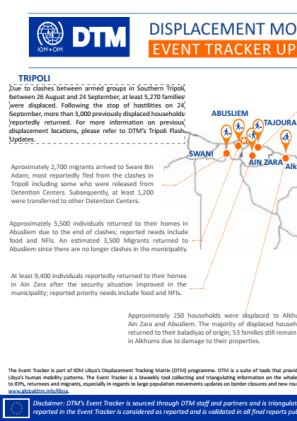-
Countries
-
Data and Analysis
-
Special Focus
-
Crisis Responses
Libya
Sobre Libya
Libya is a geographically vast country with several regions that are difficult to access. In order to understand the full scope of humanitarian assistance that is needed throughout the country, IOM established the Displacement Tracking Matrix (DTM) programme in 2016 in order to provide a common operating picture concerning the movement of populations in Libya, allowing humanitarian actors to provide timely assistance to those in need. Following the escalation of conflict and insecurity in 2014, the security situation has remained volatile since with fluctuations in the intensity of localized clashes. Congruently, conflict has caused new displacements, often in areas ill-equipped to accommodate large population movements while also negatively impacting the large migrant population residing and transiting through Libya. More recently, the capital Tripoli was heavily affected by displacement waves in September 2018 and April 2019.
DTM’s mobility tracking and flow monitoring activities identified many migrants in-country to be in need of various forms of assistance. Libya’s geographic location, resources and work opportunities has made it both a country of destination and transit for migrants for many years. Despite the deterioration of the security situation since 2011 migrants continue coming to and transiting through Libya, the majority from Sub-Saharan and North African countries.
In this complex operating environment, DTM Libya has been providing a common operating picture concerning the movement of populations in Libya since 2016, allowing humanitarian actors to provide timely assistance to those in need. Through its mobility tracking, flow monitoring and needs assessment activities, DTM Libya has established itself as data hub for quantitative data on migratory flows to and within Libya, migrant presence in Libya disaggregated by nationality and area, as well as humanitarian needs of migrants, internally displaced population and returnees. All activities are implemented through periodical bi-monthly data collection cycles, allowing trend analysis over time to provide evidence-base for both policy-level discussions and to guide humanitarian action.
In order to facilitate humanitarian interventions, DTM works closely with IOM’s other programmes through referring identified populations in need of assistance at flow monitoring points to IOM’s Direct Assistance, Health, Voluntary Humanitarian Return (VHR), Protection and Migrant Rapid Response Mechanism (MRRM) programmes. Furthermore, DTM Libya supports other humanitarian partners through providing emergency tracking updates in case of sudden population movements as well as facilitating humanitarian assessments for the Rapid Response Mechanism (RRM) jointly implemented by IOM, UNICEF, WFP and UNFPA.
For more information on IOM's activities in Libya, please visit the IOM Libya country office website.
Contacto
DTM Libya
DTMLibya@iom.int
Current Donors
- EUTF
Para obtener resultados de búsqueda más avanzados, vaya a la Página de búsqueda avanzada de informes
Libya — Displacement Event Tracking Report (1-31 Dec) [Arabic]
About 4,400 migrants arrived to Abu Sliem during the reporting period, 6,300 migrants arrived to Ain Zara, 150 Migrants to Hrawa ,250 to Sirt and 500 to Benghazi.
Libya — Displacement Event Tracking Report (1-31 Dec)
About 4,400 migrants arrived to Abu Sliem during the reporting period, 6,300 migrants arrived to Ain Zara, 150 Migrants to Hrawa ,250 to Sirt and 500 to Benghazi.
Libya — Detention Centre Profile Generator (December 2018)
Detention Centre Profiling is a component of IOM Libya's Displacement Matrix programme. It is a data oriented tool that routinely provides specific sex and age demographic data and key sectorial information on individuals held in Libya's detention Centres.
Libya — Voluntary Humanitarian Return Update (1-15 December 2018)
This fact sheet provides a bi-weekly update on Voluntary Humanitarian Returns carried out by IOM Libya. During the reporting period, 502 stranded migrants were assisted to return to their home countries.
Libya — Maritime Update Libyan Coast (1-15 December 2018)
This fact sheet provides a bi-weekly update on migration-related events off the Libyan coast. During the reporting period, 10 migrants were returned to the Libyan shore, 2 bodies were retrieved and 13 migrants went missing at sea.
Libya — Migrant Report 22 (Arabic) (Sep - Oct 2018)
تمكنت مصفوفة تتبع النزوح من إحصاء وجود ما لا يقلّ عن 670.920 مهاجرا في ليبيا خلال الجولة الـ22. وقد توزّع المهاجرون في كلّ البلديات في ليبيا داخل 558 محلّة. وانحدر أصلهم من أكثر من 39 بلدا.
Libya — Voluntary Humanitarian Return Update (1-15 December 2018) [Arabic]
This fact sheet provides a bi-weekly update on Voluntary Humanitarian Returns carried out by IOM Libya. During the reporting period, 502 stranded migrants were assisted to return to their home countries.
Libya — Maritime Update Libyan Coast (1-15 December 2018) [Arabic]
This fact sheet provides a bi-weekly update on migration-related events off the Libyan coast. During the reporting period, 10 migrants were returned to the Libyan shore, 2 bodies were retrieved and 13 migrants went missing at sea.
Libya — Migrant Report Key Findings R22 (Sep - Oct 2018)
Migrant Report Round 22 Key Findings
Libya — Migrant Report 22 (Sep - Oct 2018)
In Round 22, DTM identified there to be at least 670,920 migrants in Libya. Migrants were identified in all baladiyas, within 558 communities and originated from more than 39 countries.
Dec 19 2018
Libya — Migrant Report 22 (Sep - Oct 2018)
Libya — Detention Centre Profile Generator (November 2018)
Detention Centre Profiling is a component of IOM Libya's Displacement Matrix programme. It is a data oriented tool that routinely provides specific sex and age demographic data and key sectorial information on individuals held in Libya's detention Centres.
Libya — Displacement Event Tracking Report (1-30 November) [Arabic]
Approximately 40 individuals returned to their homes in Hrawa after having been displaced to Aljufra and Ejdabia in 2016; reported priority needs of the returnees include NFIs and access to cash.
Libya — Displacement Event Tracking Report (1-30 November)
Approximately 40 individuals returned to their homes in Hrawa after having been displaced to Aljufra and Ejdabia in 2016; reported priority needs of the returnees include NFIs and access to cash.
Libya — IDP and Returnee Report 22 (September - October 2018)
This report presents the findings of Round 22 of DTM data collection,which took place in September and October 2018. During the reporting period the number of identified returnees in Libya increased to 403,978 (+21,756), largely due to a return movement in Derna following
Libya — IDP and Returnee Report 22 (September - October 2018)
يعرض هذا التقرير نتائج الجولة 22 من جمع بيانات DTM ، التي جرت في سبتمبر وأكتوبر 2018. وخلال الفترة المشمولة بالتقرير ، ارتفع عدد العائدين المحددين في ليبيا إلى 403،978 (+21،756) ، ويرجع ذلك إلى حد كبير إلى حركة العودة في درنة بعد
Libya — IDP & Returnee Dashboard Rd 22 (September - October 2018)
This report presents the findings of Round 22 of DTM data collection, which took place in September and October 2018. During the reporting period the number of identified returnees in Libya increased to 403,978
Dec 03 2018
Libya — IDP & Returnee Dashboard Rd 22 (Septem…
Libya — Detention Centre Profile Generator (October 2018)
Detention Centre Profiling is a component of IOM Libya's Displacement Matrix programme. It is a data oriented tool that routinely provides specific sex and age demographic data and key sectorial information on individuals held in Libya's detention Centres.
( ليبيا — تقرير تتبّع أحداث النّزوح ( 1-31 أكتوبر
.يمثل مراقب الأحداث جزءا من مشروع مصفوفة تتبع النزوح مجموعة من الأدوات التي توفرلنا نقلا شاملا لأنماط التنقل البشرية بليبيا
Libya — Displacement Event Tracking Report (1-31 October)
As the security situation remained calm during the reporting period, 250 families returned to their homes. 13 families are still displaced in Tajoura following the clashes in September, unable to return due to severe damage to their homes.
Libya — Displacement Event Tracking Report (1-30 September)
Due to clashes between armed groups in Southern Tripoli between 26 August and 24 September, at least 5,270 families were displaced. Following the stop of hostilities on 24 September, more than 3,000 previously displaced households reportedly returned.
Libya — Detention Centre Profile Generator (September 2018)
Detention Centre Profiling is a component of IOM Libya’s Displacement Matrix programme. It is a data-oriented tool that routinely provides specific sex and age demographic data and key sectorial information on individuals held in Libya’s detention Centres on the date of assessment.
Migrant Report Key Findings 21 (July — August 2018)
In Round 21, DTM identified there to be at least 669,176 migrants in Libya.
Libya — Migrant Report 21 (July — August 2018)
In Round 21, DTM identified there to be at least 669,176 migrants in Libya.
Oct 03 2018
Libya — Migrant Report 21 (July — August 2018)
Libya — Baladiya Data Generator Round 21 (July - August)
This is an interactive profile generator that displays snapshots of each of Libya’s 100 baladiyas gathered through DTM Libya’s Mobility Tracking assessments. Basic multisectorial data on the baladiya is presented in addition to data on IDPs, returnees and and migrants in the baladiya.
Pagination
Para obtener resultados de búsqueda más avanzados, vaya a la Página de búsqueda avanzada de conjuntos de datos
Pagination
- First page
- Previous page
- 1
- 2
- 3
- 4
- 5


